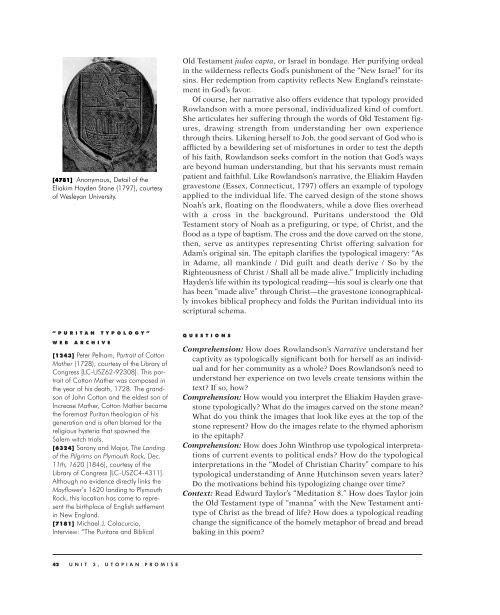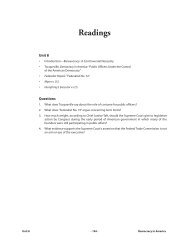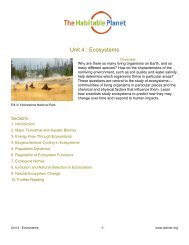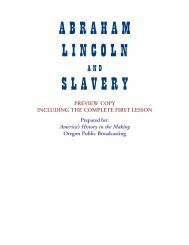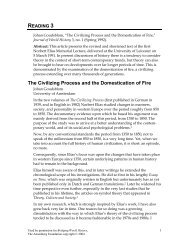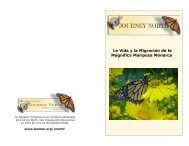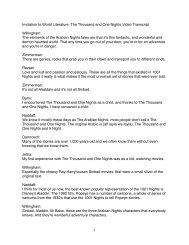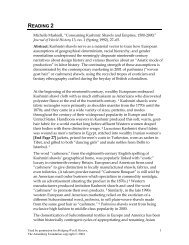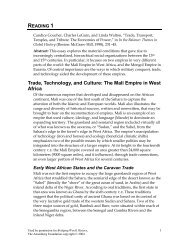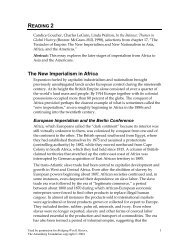UTOPIAN PROMISE - Annenberg Media
UTOPIAN PROMISE - Annenberg Media
UTOPIAN PROMISE - Annenberg Media
Create successful ePaper yourself
Turn your PDF publications into a flip-book with our unique Google optimized e-Paper software.
[4781] Anonymous, Detail of the<br />
Eliakim Hayden Stone (1797), courtesy<br />
of Wesleyan University.<br />
“PURITAN TYPOLOGY”<br />
WEB ARCHIVE<br />
[1243] Peter Pelham, Portrait of Cotton<br />
Mather (1728), courtesy of the Library of<br />
Congress [LC-USZ62-92308]. This portrait<br />
of Cotton Mather was composed in<br />
the year of his death, 1728. The grandson<br />
of John Cotton and the eldest son of<br />
Increase Mather, Cotton Mather became<br />
the foremost Puritan theologian of his<br />
generation and is often blamed for the<br />
religious hysteria that spawned the<br />
Salem witch trials.<br />
[6324] Sarony and Major, The Landing<br />
of the Pilgrims on Plymouth Rock, Dec.<br />
11th, 1620 (1846), courtesy of the<br />
Library of Congress [LC-USZC4-4311].<br />
Although no evidence directly links the<br />
Mayflower’s 1620 landing to Plymouth<br />
Rock, this location has come to represent<br />
the birthplace of English settlement<br />
in New England.<br />
[7181] Michael J. Colacurcio,<br />
Interview: “The Puritans and Biblical<br />
42 UNIT 3, <strong>UTOPIAN</strong> <strong>PROMISE</strong><br />
Old Testament judea capta, or Israel in bondage. Her purifying ordeal<br />
in the wilderness reflects God’s punishment of the “New Israel” for its<br />
sins. Her redemption from captivity reflects New England’s reinstatement<br />
in God’s favor.<br />
Of course, her narrative also offers evidence that typology provided<br />
Rowlandson with a more personal, individualized kind of comfort.<br />
She articulates her suffering through the words of Old Testament figures,<br />
drawing strength from understanding her own experience<br />
through theirs. Likening herself to Job, the good servant of God who is<br />
afflicted by a bewildering set of misfortunes in order to test the depth<br />
of his faith, Rowlandson seeks comfort in the notion that God’s ways<br />
are beyond human understanding, but that his servants must remain<br />
patient and faithful. Like Rowlandson’s narrative, the Eliakim Hayden<br />
gravestone (Essex, Connecticut, 1797) offers an example of typology<br />
applied to the individual life. The carved design of the stone shows<br />
Noah’s ark, floating on the floodwaters, while a dove flies overhead<br />
with a cross in the background. Puritans understood the Old<br />
Testament story of Noah as a prefiguring, or type, of Christ, and the<br />
flood as a type of baptism. The cross and the dove carved on the stone,<br />
then, serve as antitypes representing Christ offering salvation for<br />
Adam’s original sin. The epitaph clarifies the typological imagery: “As<br />
in Adame, all mankinde / Did guilt and death derive / So by the<br />
Righteousness of Christ / Shall all be made alive.” Implicitly including<br />
Hayden’s life within its typological reading—his soul is clearly one that<br />
has been “made alive” through Christ—the gravestone iconographically<br />
invokes biblical prophecy and folds the Puritan individual into its<br />
scriptural schema.<br />
QUESTIONS<br />
Comprehension: How does Rowlandson’s Narrative understand her<br />
captivity as typologically significant both for herself as an individual<br />
and for her community as a whole? Does Rowlandson’s need to<br />
understand her experience on two levels create tensions within the<br />
text? If so, how?<br />
Comprehension: How would you interpret the Eliakim Hayden gravestone<br />
typologically? What do the images carved on the stone mean?<br />
What do you think the images that look like eyes at the top of the<br />
stone represent? How do the images relate to the rhymed aphorism<br />
in the epitaph?<br />
Comprehension: How does John Winthrop use typological interpretations<br />
of current events to political ends? How do the typological<br />
interpretations in the “Model of Christian Charity” compare to his<br />
typological understanding of Anne Hutchinson seven years later?<br />
Do the motivations behind his typologizing change over time?<br />
Context: Read Edward Taylor’s “Meditation 8.” How does Taylor join<br />
the Old Testament type of “manna” with the New Testament antitype<br />
of Christ as the bread of life? How does a typological reading<br />
change the significance of the homely metaphor of bread and bread<br />
baking in this poem?


